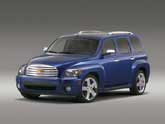Recent Articles
Popular Makes
Body Types
2006 Chevrolet HHR First Drive
Looking for a date, Chevy’s HHR may be too late
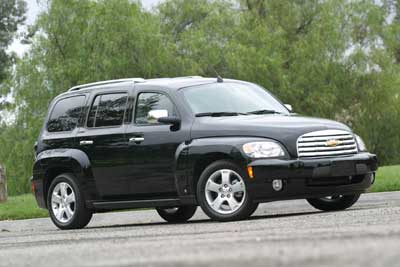
SAN FRANCISCO – People weren’t looking. We’re used to seeing others craning their necks, giving us a thumbs up, nodding their heads, or even smiling in our direction when we drive a new car before it’s come to market. Maybe San Francisco wasn’t the best city, or Napa Valley the perfect region, for the first drive of the 2006 Chevrolet HHR, as we spent the better part of a day motoring along largely unnoticed. Maybe a small town in West Virginia, North Dakota, or Iowa – or some region in the back of the beyond – would have been better. After all, the Golden Gate city and its nearby wine country are populated with hip and trendy folks used to new-car parades snaking along the tarmac. Not only that, nearly every vintage and style of automobile crafted over the past 50 years putts or zooms down the local roads or ‘catches rays’ in farm fields. But, having come to this area for many new model introductions over the years, what stood out was that the all-new Chevy HHR didn’t stand out.Built on the same small-car platform as the Chevrolet Cobalt, the 2006 HHR (Heritage High Roof) joins America’s booming market for crossovers of every size and stripe. Consumers are mad for car-based vehicles that blend the styling attributes and utility of SUVs, station wagons, minivans, and pickup trucks, thanks in part to a crossover’s higher vantage point for driving and usually available all-wheel-drive system. Borrowing its naming scheme from the Chevy SSR, a clever and attractive pickup that also pays homage to the past, the four-door, five-passenger HHR has been penned to honor the 1949 Chevy Suburban, a model that GM’s best-selling brand espouses as the first utility vehicle when the nameplate debuted in the mid-1930s. Heritage aside, the retro-styled 2006 Chevrolet HHR looks a lot like the Chrysler PT Cruiser, a player that came to the party five years ago, and it wears practically the same outfit. In fact, the HHR’s dimensions are nearly the same, as well as the similar interior layout and seating positions. The likeness is not at all surprising since the same designer, Bryan Nesbitt, sketched both the PT and the HHR. Even though the “cute” factor is high (think panel or bread truck), the blocky Chevrolet is more masculine in appearance than the curvy Chrysler, thanks to its flat roofline and more angular detailing. Plus, by the end of our daylong ride and drive, we had to admit: There were some things we liked about the modestly priced HHR. But, a bold and important question loomed in our car guru brains: With Chrysler dealers giving away PT Cruisers, who will buy the essentially identical 2006 Chevrolet HHR?
Model Mix
Model Mix The top level HHR 2LT starts at $18,790 and is fitted with the larger 2.4-liter engine as standard equipment. Wheel diameter grows to an impressive 17 inches, with high-polished versions available, and the 2LT also has a sport-tuned suspension. Chevy offers three levels of trim for its 2006 HHR. Starting at $15,990, base LS models are powered by a 143-horsepower, 2.2-liter, Ecotec inline four-cylinder engine bolted to either a standard five-speed manual or optional four-speed automatic transmission. Some impressive comes standard, like power windows, door locks, and mirrors; keyless entry; air conditioning with air filtration; cruise control; 16-inch wheels; and a six-speaker stereo with a CD player. The standard air conditioning is a plus for the HHR, since a similarly priced base Chrysler PT Cruiser offers it only as a $1,000 option. Mid-level models, dumbly dubbed 1LT, cost $16,990, and still include the 2.2-liter engine as standard but can be fitted with an optional 172-horsepower, 2.4-liter Ecotec engine. You also get a few more standard goodies, such as an MP3 player, an eight-way power driver’s seat with lumbar support, alloy wheels, and satin exterior trim. Choosing the HHR 1LT also expands the list of optional amenities, making available a power sunroof, leather seats with front heating, a six-disc CD changer, a leather-wrapped shift knob and steering wheel, and the Bright Chrome Exterior Appearance Package (which dips the grille, liftgate bar, door handles, exterior mirrors, and roof rails in the shiny stuff).
The top level HHR 2LT starts at $18,790 and is fitted with the larger 2.4-liter engine as standard equipment. Wheel diameter grows to an impressive 17 inches, with high-polished versions available, and the 2LT also has a sport-tuned suspension. Chevy’s Bright Chrome Exterior Appearance Package is standard on the 2LT, as are the leather-wrapped steering wheel and shift knob, and the six-disc CD changer. Antilock brakes and an auto-dimming rearview mirror are also included. Notable options on the 2006 Chevrolet HHR, in addition to the power sunroof and leather interior, include OnStar telematics, XM satellite radio, and side curtain airbags.
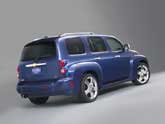
Nuts and Bolts
Nuts and Bolts The Chrysler PT Cruiser GT’s high-pressure turbocharged engine crushes the Chevy HHR’s most powerful motor, delivering 220 horses and 245 lb.-ft. of torque compared to 172 ponies and 162 lb.-ft. of twist. Falling just shy, in terms of output, of the 2.4-liter four-cylinder engine in the base Chrysler PT Cruiser, the 2006 Chevrolet HHR’s standard 2.2-liter engine makes 143 horsepower at 6,000 rpm and 150 lb.-ft. of torque at 4,000 rpm, compared to the Chrysler’s yield of 150 horsepower and 165 lb.-ft. of torque. The Chevy’s deficiency grows when comparing top powerplants. Despite sophisticated engineering like variable valve timing, individual coils at each spark plug, and auxiliary oil cooling, the HHR’s 2.4-liter unit lacks output because of its natural aspiration. This engine’s 172 horsepower at 6,000 rpm and 162 lb.-ft. of torque at 5,000 rpm comes up short of the Chrysler’s 180-horsepower, 210 lb.-ft., 2.4-liter low-pressure turbocharged motor. Furthermore, the PT Cruiser GT’s high-pressure turbocharged engine crushes the HHR, delivering 220 horses and 245 lb.-ft. of torque. But in fairness to the HHR, the PT Cruiser GT’s base price is nearly $24,000. Both vehicles employ standard five-speed manual and optional four-speed automatic transmissions to drive the front wheels. And with similar curb weights, the lack of power can certainly be considered a huge performance handicap for the HHR. The Chevy HHR LS’s touring suspension has been optimized for comfort in everyday driving situations, while the sport setup on 2LT models improves handling thanks to aluminum front control arms, variable-rate rear springs, and gas-charged monotube shocks. Optional antilock brakes (standard on the 2LT) are integrated with a traction control system, which can be disengaged by the driver, but a stability control system is not offered on the HHR. Electric speed-sensitive, rack-and-pinion steering guides the 2006 Chevrolet HHR to its destination.
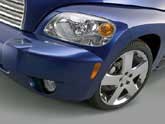
Design
Design Once inside, the HHR again falters when compared with the PT Cruiser. Despite a 7.4-inch advantage in overall length and a 2-inch edge in width, the HHR offers less rear head and legroom than the Chrysler. GM designers say the 2006 Chevrolet HHR was penned to resemble a 1949 Suburban, but the resemblance to Chrysler’s PT Cruiser is unmistakable, especially from the front end. Bryan Nesbitt made design decisions for the HHR, the same person who, while working at Chrysler, styled the PT Cruiser. Like those of the Chrysler, the HHR’s wheelwells flare substantially into the front and rear doors. Both feature headlights set into the front fenders, although the HHR’s illuminators rest a bit lower. A bulging hood acts as a kind of snout, expanding as it progresses rearward like a post-WWII model. Around back, the HHR’s taillights reside in the body, while Chrysler places them in the back of the fenders. The PT Cruiser also has a much more noticeable wedge shape, whereas the HHR appears level, upright and planted. Once inside, the HHR again falters when compared with the PT Cruiser. Despite a 7.4-inch advantage in overall length and a 2-inch edge in width, the HHR offers less rear head and legroom than the Chrysler. With 40.9 inches of rear legroom the PT outguns the HHR by 1.4 inches, and the 39.5 inches of rear headroom in the Chrysler bests the Chevy by 0.5 inches. Front headroom in the Chevy is slightly better – 39.6 compared to 39.2 inches – and front legroom is even at 40.6 inches. Chrysler also trumps Chevy in terms of cargo capacity, as the PT offers 64.2 cubic feet to the HHR’s 63.1, with the front passenger chair and rear seats folded flat. Comparatively, a Scion xB offers more front headroom, rear headroom, and front seat legroom than the HHR and PT Cruiser, in a much smaller package at 155.3 inches in length. At 169.3 inches long, Honda’s Element provides more front headroom and legroom, but less space in the back seats. Cargo volume in the Element beats both domestic retro-wagons at 74.6 cubic feet.
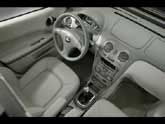
Safety and Storage
Safety and Storage Chevy has put extra effort into the HHR’s cargo system to increase volume and ease of storage. The front passenger seat folds flat, allowing long objects such as an eight-foot ladder or a kayak to extend from the closed liftgate to the dashboard. Safety features on the 2006 Chevrolet HHR include standard dual front airbags, with side curtain airbags for both rows available as an option. The front seatbelts feature pre-tensioners that automatically tighten, and the center rear seat has a three-point shoulder harness. OnStar telematics, which can notify rescue personnel when the airbags deploy, is optional. Technology like brake assist and stability control, increasingly available on lower priced vehicles, is not offered on the HHR.
Chevy has put extra effort into the HHR’s cargo system to increase volume and ease of storage. The front passenger seat folds flat, allowing long objects such as an eight-foot ladder or a kayak to extend from the closed liftgate to the dashboard. Other features include a five-inch-deep, recessed bin below the cargo floor, the ability to mount the primary load floor two feet higher as a shelf, and two larger storage bins ahead of the load floor. Plus, the HHR features door pocket storage bins and cargo tie-downs. Though the HHR trails its main competitors in maximum cargo capacity, its innovations are appealing. However, a true center storage console is missing. In its place are three cupholders; two for front seat passengers and one for rear seat riders, just like in a PT Cruiser. The glovebox, which is located in the center of the instrument panel, can accommodate a cell phone, wallets and other small items for stowage.
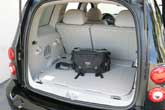
Driving Impressions
Driving Impressions While the 2.4-liter motor provided enough everyday power for the HHR, we cannot comment on the lower-powered 2.2-liter, except to say that we would imagine the desire for more horses under many circumstances. We drove 2006 Chevrolet HHR’s in 1LT and 2LT trim, both equipped with the 2.4-liter engine, over a 150-mile long route that took us from the San Francisco cityscape to the curvy two-lanes of the Napa Valley region, making sure to try both of GM’s sturdy transmissions, preferring the manual for more snappy driving. While the 2.4-liter motor provided enough everyday power for the HHR, we cannot comment on the lower-powered 2.2-liter, except to say that we would imagine the desire for more horses under many circumstances. We were impressed with the HHR’s overall handling, and particularly appreciated its well-modulated brakes and the sport-tuned suspension setup that nicely controls body roll, dive, and squat. Our preference of suspensions was softer Touring setup, finding that 2LT’s sport-tuned underpinnings transmitted a more harsh road feel. Steering was light at slow speeds, but stiffened appreciably at higher speed and carved corners with ample confidence for a vehicle of this class. And thanks to the use of special laminated “quiet steel” in the frame and vehicle architecture, the interior provides a hushed environment making the HHR a pleasant place to spend time. Passing a Chrysler PT Cruiser on our ride route, we would have to agree with GM that there is a different personality and character inherent in the boxy HHR. That personality was somewhat bi-polar, however, as we found a number of quality disappointments that quelled our enthusiasm for its performance. While we found the overall styling somewhat appealing, the large gaps in the HHR’s sheetmetal were anything but. Large, easy-opening doors with industry-first door handles that accommodate a gloved hand bring you into a cabin with attractive, comfortable seats constructed of pleasant materials, but other finishes and materials appeared cheap. And, despite a number of amenities, we found the gauges and controls small and uninspiring – although the LED that provides ambient light over the lower controls and the door handles is a nice touch.
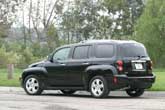
Wrap-Up
Wrap-Up Appealing to drive, value priced, and featuring an expected fuel economy rating in the mid-20s, the HHR holds appeal. But compared to the Chrysler PT Cruiser after which it’s patterned, it comes up short on power and utility. Calling the 2006 Chevrolet HHR “the next entry in the American revolution,” General Motors plans to reach customers by traditional-outlet advertising during the World Series, NFL games, music festivals (like the Country Music Awards), and concerts. Additionally, Chevy will use internet-based marketing in the hopes of building a creative image of “urban cool” that appeals to “younger mindset buyers,” and owners who like to customize their vehicles. In particular Chevrolet expects the HHR will be a big hit on the west coast. Based on our time with the 2006 Chevrolet HHR, we see a few positives. Positioned below the larger Chevy Equinox SUV, and modified from the Chevy Cobalt’s impressive architecture, the HHR is value priced and fitted with GM’s durable Ecotec four-cylinder powertrains. Appealing to drive, featuring an expected fuel economy rating in the mid-20s, and equipped with a smattering of everyday and slightly upscale amenities, the HHR holds appeal. But compared to the Chrysler PT Cruiser after which it’s patterned, it comes up short on power, space and utility. And, say what you will about the styling, but one thing is for sure. During the HHR’s first miles on American highways, people weren’t looking.
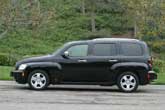
Specifications
Specifications The 2006 Chevrolet HHR’s competitors include the Chrysler PT Cruiser, Ford Focus ZX5, Honda Element, Hyundai Elantra GT, Kia Spectra 5, Mazda 3s 5-door, Pontiac Vibe, Scion xB, Subaru Outback Sport, Suzuki Reno, and Toyota Matrix. Test Vehicle: 2006 Chevrolet HHR Base Price: $15,990 (LS); $16,990 (1LT); $18,790 (2LT) (includes destination charge of $565) Engine Size and Type: 2.2-liter inline-four (LS, 1LT); 2.4-liter inline-four (optional 1LT, standard 2LT) Engine Horsepower: 143 at 6,000 rpm (2.2-liter); 172 at 6,200 rpm (2.4-liter) Engine Torque: 150 lb.-ft. at 4,000 rpm (2.2-liter); 162 lb.-ft. at 5,000 rpm (2.4-liter) Transmission: five-speed manual (standard); four-speed automatic (optional) Curb weight, lbs.: 3,155 (2.2-liter); 3,208 (2.4-liter) EPA Fuel Economy (city/highway): 22/27 mpg (2.2-liter manual); 22/26 mpg (2.2-liter automatic); 22/26 mpg (2.4-liter manual); 20/25 mpg (2.4-liter automatic) Length: 176.2 inches Width: 69.1 inches Wheelbase: 103.5 inches Height: 63.1 inches Head room (front/rear): 39.6/39 inches Leg room (front/rear): 40.6/39.5 inches Max. Seating Capacity: Five Max. Cargo Volume: 23.8 cubic feet (rear seat up); 63.1 cubic feet (rear seat down) Max. Towing Capacity: 1,000 lbs. Competitors: Chrysler PT Cruiser, Ford Focus ZX5, Honda Element, Hyundai Elantra GT, Kia Spectra 5, Mazda 3s 5-door, Pontiac Vibe, Scion xB, Subaru Outback Sport, Suzuki Reno, and Toyota Matrix.
Photos courtesy of General Motors
